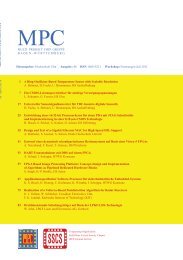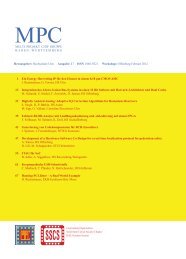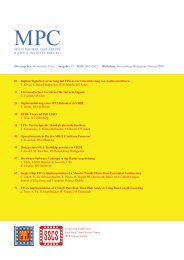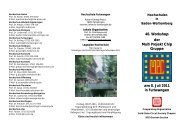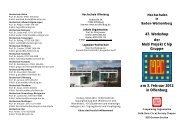Workshopband als PDF - Mpc.belwue.de
Workshopband als PDF - Mpc.belwue.de
Workshopband als PDF - Mpc.belwue.de
Sie wollen auch ein ePaper? Erhöhen Sie die Reichweite Ihrer Titel.
YUMPU macht aus Druck-PDFs automatisch weboptimierte ePaper, die Google liebt.
Figure 8: Measured (dots) and simulated (full line) IVcharacteristic<br />
of blue light emitting LED at different light levels<br />
of ambient light.<br />
of the emitted light. Therefore we could take approximate<br />
values for the minimum energy gap EG for the<br />
simulation. Results are given in figure 7 showing the<br />
correct behavior. Only in the low IV region differences<br />
between measured and simulated curves are<br />
observed. More <strong>de</strong>tailed temperature analysis will be<br />
possible with manufacturer data on the material composition<br />
of the LED’s.<br />
C. Ambient light influence<br />
LED’s are often utilized in environment with ambient<br />
light. The pn junction of the LED with applied<br />
voltage such that the LED emits light will <strong>als</strong>o be<br />
sensitive to ambient light. This means that the ambient<br />
light produces some photocurrent in the pn junction of<br />
the LED and the LED <strong>de</strong>tects the ambient light [5].<br />
This will influence the IV-characteristic in the region<br />
of low IV values strongly. In figure 8 we show measured<br />
and simulated data of the IV characteristic of the<br />
blue light emitting dio<strong>de</strong> un<strong>de</strong>r increasing ambient<br />
light level. For the simulation of the generated photocurrent,<br />
we introduced a current source in the circuit<br />
(figure 9). The curves clearly show that our mo<strong>de</strong>l still<br />
holds for LED’s working un<strong>de</strong>r ambient light illumination.<br />
V. SUMMARY<br />
In the present work we have <strong>de</strong>veloped a general<br />
mo<strong>de</strong>l for high-power LED’s based on elementary<br />
i<strong>de</strong>al electronic circuit elements. We have shown that<br />
the mo<strong>de</strong>l<br />
• can be applied to LED’s of different type with<br />
only minor mo<strong>de</strong>l modifications,<br />
• <strong>de</strong>scribes well the temperature behavior,<br />
• is <strong>als</strong>o suitable to characterize the LED un<strong>de</strong>r<br />
ambient illumination.<br />
ACKNOWLEDGEMENT<br />
The authors thank the MPC group Ba<strong>de</strong>n – Württemberg<br />
for financial support.<br />
16<br />
DC FORWARD MODEL OF HIGH-POWER LED’S<br />
Figure 9: Electric circuit for simulation of LED with ambient<br />
illumination.<br />
REFERENCES<br />
[1] E.F. Schubert, “Light-Emitting Dio<strong>de</strong>s”, Cambridge University<br />
Press, 2010.<br />
[2] G. Massobrio and P. Antognetti, “Semiconductor Device<br />
Mo<strong>de</strong>ling with Spice”, McGraw-Hill, 1998.<br />
[3] S.M. Sze, “Physics of Semiconductor Devices”, John Wiley<br />
& Sons, 1981.<br />
[4] F. Sischka, “Dio<strong>de</strong> Mo<strong>de</strong>ling”, Agilent Technologies, 2003.<br />
[5] V. Lange, F. Lima and D. Kühlke, „Multicolor LED in Luminescence<br />
Sensing Application”, Sensors and Actuators A<br />
169, 2011, pp. 43-48.<br />
Volker Lange received his diploma <strong>de</strong>gree in<br />
physics and his Ph.D. from the University of<br />
Freiburg. Since 1991, he is a scientific<br />
assistant at Furtwangen University, faculty<br />
Computer and Electrical Engineering. His<br />
scientific interests are semiconductor measurement<br />
technology and optical sensor and<br />
measurement technology.<br />
Brenton Sherston studied Electrical and<br />
Electronic Engineering at Murdoch University<br />
in Perth. He majored in Electrical<br />
Power and Industrial Computer Systems<br />
Engineering. He performed his Bachelor of<br />
Engineering Thesis at Furtwangen University<br />
in Germany in 2012. He currently works<br />
for First Quantum Miner<strong>als</strong> as an Electrical<br />
Engineer in Zambia, where he is responsible<br />
for the mining operations electrical power<br />
grid.<br />
Robert Hönl received his diploma <strong>de</strong>gree in<br />
Electrical Engineering and his Dr. Ing. from<br />
University of Berlin. Until 1993 he was<br />
product <strong>de</strong>velopment manager at Krone<br />
AG. Now, he is a professor at Furtwangen<br />
University, faculty Computer and Electrical<br />
Engineering. His scientific interests are<br />
measurement-, sensor-, control engineering<br />
and project management.



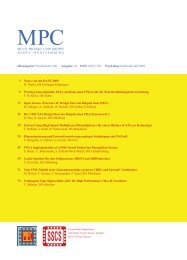
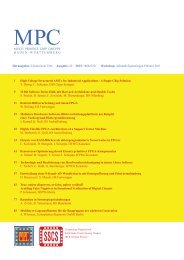
![[Geben Sie hier die Überschrift ein] - MPC](https://img.yumpu.com/8654082/1/188x260/geben-sie-hier-die-uberschrift-ein-mpc.jpg?quality=85)
